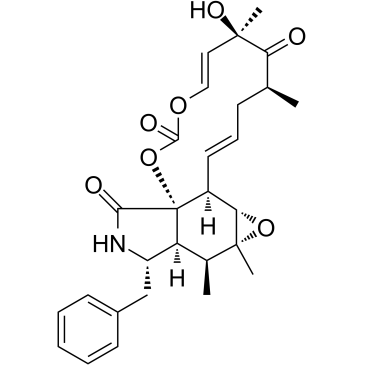Retinal pigment epithelial cells phagocytosis of T lymphocytes: possible implication in the immune privilege of the eye.
F Willermain, L Caspers-Velu, B Nowak, P Stordeur, R Mosselmans, I Salmon, T Velu, C Bruyns
Index: Br. J. Ophthalmol. 86(12) , 1417-21, (2002)
Full Text: HTML
Abstract
To investigate the capability of retinal pigment epithelium (RPE) cells to phagocytose T lymphocytes and to further analyse the immunobiological consequences of this phagocytosis.Human RPE cells pretreated or not by cytochalasin, a phagocytosis inhibitor, were co-cultured with T lymphocytes for different time points. Phagocytosis was investigated by optic microscopy, electron microscopy, and flow cytometry. T cell proliferation was measured by (3)H thymidine incorporation. RPE interleukin 1beta mRNA expression was quantified by real time PCR.RPE cells phagocytose apoptotic and non-apoptotic T lymphocytes, in a time dependent manner. This is an active process mediated through actin polymerisation, blocked by cytochalasin E treatment. Inhibition of RPE cell phagocytosis capabilities within RPE-T cell co-cultures led to an increase of lectin induced T cell proliferation and an upregulation of interleukin 1beta mRNA expression in RPE cells.It is postulated that T lymphocyte phagocytosis by RPE cells might, by decreasing the total number of T lymphocytes, removing apoptotic lymphocytes, and downregulating the expression of IL-1beta, participate in vivo in the induction and maintenance of the immune privilege of the eye, preventing the development of intraocular inflammation.
Related Compounds
| Structure | Name/CAS No. | Molecular Formula | Articles |
|---|---|---|---|
 |
Cytochalasin E
CAS:36011-19-5 |
C28H33NO7 |
|
Excessive expression of the plant kinesin TBK5 converts cort...
2007-05-01 [Plant Cell Physiol. 48(5) , 753-61, (2007)] |
|
Cytochalasin E alters the cytoskeleton and decreases ENaC ac...
2014-07-01 [Am. J. Physiol. Renal Physiol. 307(1) , F86-95, (2014)] |
|
Biosynthesis: A carbonate architect emerges.
2014-07-01 [Nat. Chem. Biol. 10(7) , 486-7, (2014)] |
|
A carbonate-forming Baeyer-Villiger monooxygenase.
2014-07-01 [Nat. Chem. Biol. 10(7) , 552-4, (2014)] |
|
Effects of medium calcium, and agents affecting cytoskeletal...
2012-06-01 [J. Cell. Biochem. 113(6) , 1915-25, (2012)] |